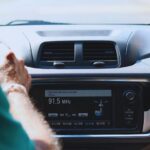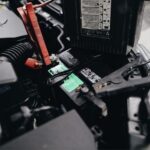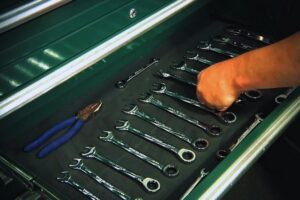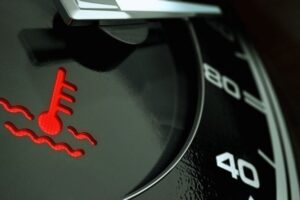Car won’t crank? You’ve come to the right place. If you’re having trouble starting your car, you’ll probably want to get it fixed as soon as possible. But what exactly is wrong with your car? And how can you fix it?
When you’re trying to start your car, and it just won’t crank, there are a few things that could be wrong. If your vehicle doesn’t turn over, consider these possible causes:
- Dead battery
- Empty fuel tank
- Bad alternator
- Bad ignition switch
- Starter motor
- Spark plugs
- Bad timing belt
- Broken distributor cap
- Clogged fuel filter
- Jammed steering lock
Read on to learn more about cars not cranking, its potential causes, and what you can do to fix this problem.
Causes for the Car Not Cranking
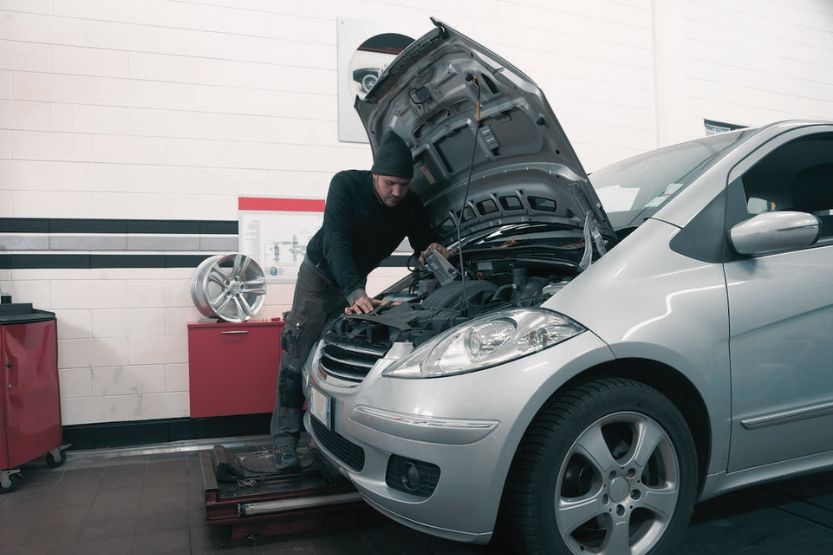
The causes of a car not cranking can be as simple as a dead battery or an issue with the starter or ignition. If you know what’s causing the problem, it’s easier to fix. In this article, we’ll cover the different things that can cause your car not to turn over.
The list isn’t exhaustive, but it’s an excellent place to start if you’re having trouble starting your car:
1. Dead Battery
Getting the car to start can be almost impossible when a car’s battery dies. Check the battery first if you’re unsure why your car engine won’t crank and if it’s not the fuel pump.
A dead battery is one of the most common reasons a vehicle does not start, especially during colder months when cars aren’t used as often.
However, the simplest problems can be the most difficult to fix sometimes. Take a dead battery, for example. It’s not a complicated problem — you need to replace it.
But sometimes, you may not easily access a replacement. How do you start your car if you’ve got a dead battery and no way to get one?
Solution
There are a few helpful ways to get your car started if you’re in this situation. First, check the battery cables and ensure they’re tight. If they’re loose, this can cause problems with starting up your car.
If that’s not the issue, try jumping your vehicle from another using jumper cables. However, because new batteries can be pricey and battery jumps are just a temporary fix, it’s in your best interest to take good care of your car’s battery.
2. Empty Fuel Tank
Fuel is one of the essential parts of your car. It keeps your vehicle running; without it, you’ll be stuck on the side of the road or worse. When your car’s fuel tank is empty, the engine has no power, so it can’t turn over and start.
It’s important to know when you’re low on fuel and refill before you run out entirely so that you don’t have to worry about it happening again.
Solution
If your gas tank is empty, your best bet is to obtain a gas can, pour a couple of gallons of gas into your vehicle, and then drive to the nearest gas station.
3. Bad Alternator
If you’re having trouble starting your car, it could be because of a bad alternator. The alternator is a component that produces electricity for your vehicle, and it’s essential to have one that works properly. If the alternator malfunctions, it can cause the car not to crank.
Solution
Replace any bad alternator.
4. Bad Ignition Switch
A bad ignition switch can cause your car not to crank, but how do you know it’s the ignition switch?
Also, did you know that the ignition switch is a crucial part of your vehicle’s electrical system? It receives power from the battery and distributes it to other parts of the engine, such as the starter.
This switch sends power to start your engine when you turn on your car. If it is faulty, your car may not start at all.
Symptoms of a Bad or Malfunctioning Ignition Switch
- You cannot hear the starter motor working as it attempts to turn over the engine.
- Because the ignition switch is responsible for activating the electrical systems in your vehicle, you may also experience electrical problems. A good sign for this would be dying or flickering dashboard lights.
- It’s also possible that you’ll have trouble turning your key.
Solution
Ensure all connections are tight, so the electrical current isn’t interrupted by loose connections or corroded wires. If all else fails, take your vehicle to a professional mechanic who can diagnose the issue and replace any faulty parts.
5. Starter Motor
If your car won’t crank but has power, you may have a starter motor problem. It’s not just bad alternators or dead batteries that can prevent your ignition from working — there are other potential causes.
Suppose the starter motor, responsible for receiving the electrical signal to crank the engine, is malfunctioning in any way. In that case, your vehicle will not respond when you turn the key.
Symptoms
Checking to see if your car’s lights come on when you turn the key in the ignition is one of the easiest ways to know whether you have a starter motor problem.
If you have turned your key all the way and the lights have come on, but the engine won’t turn over, the problem may be with your starter motor. If you keep trying to use a starter motor with a blown fuse, you might cause it to overheat, releasing smoke.
Solution
If your car has power but won’t crank, you must replace your starter motor. And it might be worth taking your car to a mechanic to have them look at it further.
6. Spark Plugs
You should first know that spark plugs ignite your engine’s fuel. Without them, gasoline-powered vehicles will not start.
The second thing you should know about spark plugs is that they need to be replaced every 20,000 or 40,000 miles.
The third thing you should know about spark plugs is that they can fail if they are too old or if they have been damaged by dirt, rust, or other foreign material. When this happens, they will stop working correctly, and your car won’t sometimes crank because it can’t ignite its fuel supply properly.
Solution
You can purchase new spark plugs or send your car to a mechanic. The former option is more cost-effective, but it may take some time to do it yourself.
7. Bad Timing Belt
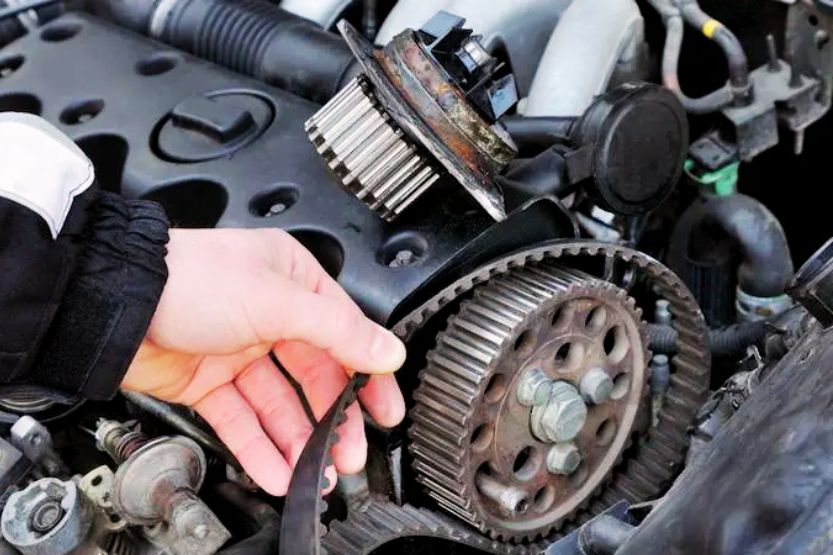
A bad timing belt can also cause your car not to crank. If you hear a loud squealing noise from under the hood of your car when you start your engine, chances are good that your timing belt needs to be replaced.
Timing belts are critical to the operation of an engine. They are made of rubber and are responsible for synchronizing the rotation of the engine’s pistons with other engine components, such as fuel injectors and valves. This allows for efficient combustion and maximum power output.
If your timing belt breaks or stretches too much, it can cause severe problems in your engine. When this happens, your car cannot start because it won’t have enough compression to turn over its engine. Usually, this is caused by poor maintenance or bad timing belt installation.
Solution
Have a certified mechanic check out your vehicle immediately to ensure that your timing belt is in good working order. If it’s not, they’ll replace it with a new one.
8. Faulty Distributor Cap
The distributor cap is essential to the ignition system since it regulates the engine’s firing order. The purpose of the distributor is to guide the flow of electrical current from the ignition coil toward the spark plugs for each cylinder in the engine in the proper firing sequence and at the appropriate time.
No matter the damage to the distributor cap, having a faulty distributor cap will almost certainly result in difficult starting problems.
Solution
You can try cleaning the cap, but this is often not enough. The best solution is to replace the faulty distributor cap with a new one.
9. Clogged Fuel Filter
A clogged fuel filter will cause the car not to crank and generally make it difficult to start.
The fuel filter filters out dirt and debris from the fuel before it reaches the engine. If this filter gets clogged up, it can cause many problems: the car won’t start or run poorly until it is cleaned out.
Solution
Ideally, you must replace your fuel filter every 30,000 miles. So if you are getting close to reaching this milestone and your vehicle will not start, you should check and perhaps replace the fuel filter. This will ensure clean fuel to power your car’s engine and keep running smoothly.
Again, what won’t your car crank? If your car doesn’t crank, it might be due to a dying battery, starter issue, damaged alternator, or corroded cables.
10. Jammed Steering Lock
If someone tries to move the steering wheel while the key is not in the ignition, your anti-theft steering lock will engage. This is done to prevent the steering wheel from being stolen. It does have the potential to serve as a deterrent to drivers sometimes.
Solution
If the steering lock on your vehicle becomes stuck, you should first attempt to wriggle it to the left and right. Next, turn it gently in whichever direction to allow some movement. Once unjammed, you should be able to turn the key, usually in the ignition.
What to Do When the Car Won’t Crank
When your car doesn’t crank, it’s incredibly frustrating. And when you’re in a bind and need to get out, it can be downright scary. However, there are some things you can do to help yourself get the car going again — before calling for roadside assistance or taking it to the shop.
So if you’re cranking the key and nothing is happening, here are things you can try:
1. Car Makes a Clicking Sound
If your vehicle makes a clicking sound when you try to start it, but it still won’t turn over, the problem could be caused by:
- A weak battery;
- Unclean battery terminals;
- A faulty starter motor; or
- A stuck solenoid.
Your car may need a jump start. But before you go and grab the jumper cables or the electric jump starter, you may try a few things first:
Try Key Cycling
If the engine won’t start, although your car is turned on, turn on the dome light and monitor it as you start the engine. If the light goes out, it indicates that the battery is getting dangerously low or is about to die.
You can use the critical cycling trick to warm up the batteries, including the terminals and the starter:
- Turn the key back repeatedly to the starting position about ten times.
- Next, stop and wait for 5 minutes.
- Try starting the engine.
- If turning the key did not cause the dome light to dim, and if your car still won’t start, proceed to the next tip.
Tap the Battery Terminals
When you are stuck and do not have access to any tools, there is no way to clean corroded battery terminals. However, you can try to relocate the terminals or, at the very least, jar them enough to get better contact.
If the vehicle would not start, use the heel of a shoe to tap each battery terminal. This will cause it to rotate slightly around the battery post. After this, try starting the car.
Tap the Starter
If you can get to the starter motor, you can try hitting it with the tire iron from the car jack. Tapping on the electrical connections can sometimes free them from being stuck.
2. No Clicking Sound When Turning the Key
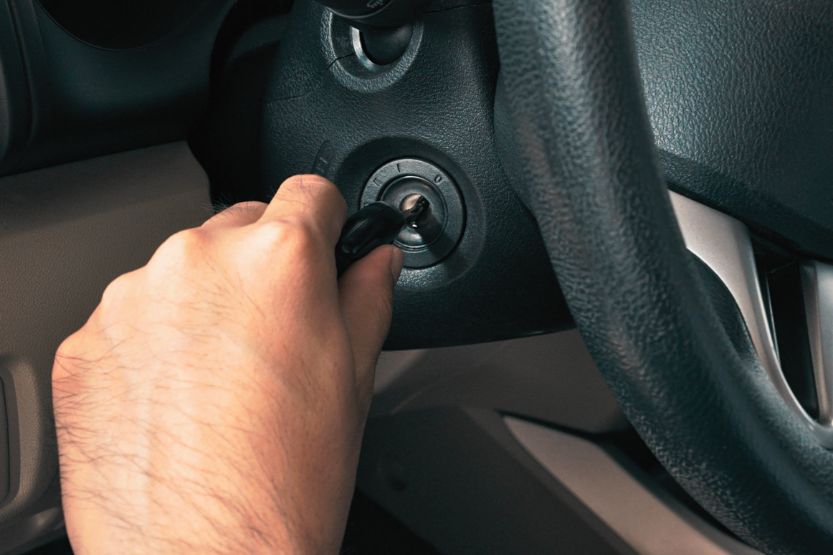
Shift the Shifter
While stepping on the brake pedal, move the shift lever to the neutral position before starting the car. If that doesn’t work, you should put it back in “Park” and give it another shot.
Reestablishing electrical contact within the transmission range selector sometimes requires moving the shifter.
3. Your Car Cranks, but It Won’t Fire Up
Swap Relays
To do this, turn the key to the run position with the radio turned off, and then listen for a buzzing sound that lasts for two seconds.
That sound you hear is the injection system being primed by the fuel pump. If there’s no sound, the fuel pump relay may be broken, or the pump itself may be on its way out.
To begin, consult your owner’s manual to locate the fuel pump relay. Pull the fuel pump relay in the upward direction. The next step is to locate another relay with the same part number. Swap it with the fuel pump and then push it into the socket. After this step, try starting the engine.
Smack the Fuel Tank
Jar the fuel pump motor by hitting the bottom of the fuel tank multiple times using the heel of your shoe. After this, try starting your car.
Unflood the Engine
The engine is flooded when you smell gas from the engine. While cranking the engine, press the accelerator pedal down to the floor and hold it there.
Trick the Computer
An air-to-fuel mixture that is too lean to start a cold engine can be due to a vacuum leak or a malfunctioning temperature sensor.
If you’ve tried all the other tips in this article, and your car still won’t start, try stepping on the accelerator halfway down before starting the engine. This will signal the computer to add more fuel.
Frequently Asked Questions – Car Turns Over But Won’t Crank
What Would Cause a Car Not to Crank Over?
If your car won’t start, it’s often caused by a dying or dead battery, corroded or loose connection cables, a bad alternator, or an issue with the starter motor. It can be hard to identify if you’re dealing with an alternator or battery problem.
What Causes No Crank No Start?
If an engine cranks but fails to start, it lacks fuel, ignition, or compression. If it ran fine but stopped suddenly, the most likely causes would be a faulty fuel pump, ignition module, or broken overhead cam timing belt.
Why Won’t My Vehicle Start, but the Battery Is Good?
To ensure good contact, you can charge the battery and clean the terminals, including cable connectors. If your vehicle doesn’t start by jump-starting, you may have a problem with your alternator, starter motor, or another electrical system component.
Conclusion – Car Not Cranking
If your car doesn’t crank, different things could be causing the problem. If you check the battery and it’s not completely dead, you might have a bad starter or a weak battery. Or, if it is completely dead, you should jump-start it to see if it fixes the problem.
But if it still doesn’t crank after jumping it, you may have a severe problem with your ignition system and need to fix it immediately. A mechanic can tell you what exactly is wrong when they look at your car. In the meantime, this article should help you figure out what to do in case your car won’t crank.
To recap, here are some potential causes for your car not cranking:
- Dead battery
- Empty fuel tank
- Bad alternator
- Bad ignition switch
- Starter motor
- Spark plugs
- Bad timing belt
- Broken distributor cap
- Clogged fuel filter
- Jammed steering lock



![Car Won’t Turn Over but Has Power [Causes and How to Fix] car wont turn over but has power](https://roadsumo.com/wp-content/uploads/2022/04/car-wont-turn-over-but-has-power-150x150.jpg)
![Brake Lights Won’t Turn Off [Causes and How to Fix] brake lights wont turn off](https://roadsumo.com/wp-content/uploads/2021/05/brake-lights-wont-turn-off-150x150.jpg)
